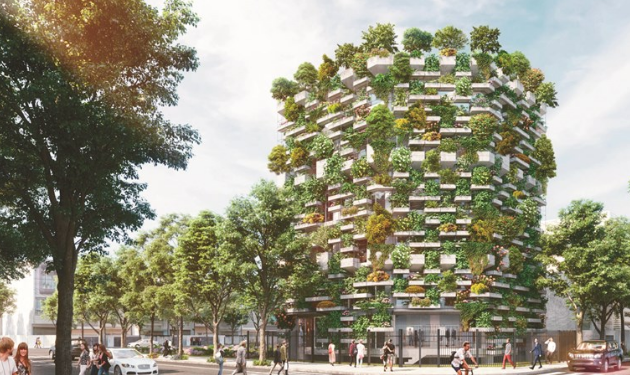In a world where urbanization often means disconnection from nature, innovative architectural solutions such as the Urban Agriculture Office in Ho Chi Minh City are bridging this gap. Designed by Vietnamese architecture firm VTN, this building turns the concept of vertical farming into a practical urban reality. By integrating flower boxes and a variety of edible plants, the building creates a micro-ecosystem where residents can harvest fruits and vegetables directly from their living spaces.
Vertical farming: the answer to climate problems
With the increasing frequency of extreme weather events impacting traditional agriculture, vertical farming has become widespread globally. Unlike conventional farming, vertical farms require less water, occupy less space, and can be located in urban environments such as buildings, containers, or indoor spaces. Methods such as hydroponics and aquaponics allow plants to be grown without soil, minimizing the risk of crop failure due to climate change.
Urban Farm Office: A Green Haven in the City
The VTN Urban Agriculture Authority is an example of this concept, which aims to restore green spaces in urban environments and promote safe food production. The building is a vertical farm structure that creates a comfortable microclimate. The combination of planter boxes and glass fronts helps filter sunlight and purify the air, while stored rainwater irrigates plants and cools the air through evaporation, effectively lowering indoor temperatures.
Construction of the Urban Farm Office is straightforward, using concrete structures, steel columns, and modular hanging flower boxes. These boxes can be easily replaced and adjusted to suit the height and growth needs of the plants, ensuring optimal sunlight exposure. This design provides a green cover rate of 190%, yielding an impressive 1.1 tons of organically grown fruits and vegetables per year.
Global examples of innovation in vertical farming
Similar initiatives are evident around the world. In Tokyo, the Pasona Group headquarters is a nine-story building with a green facade decorated with flowers and citrus trees, reminiscent of a vertical garden. Inside, urban farms occupy 20% of the office space, growing 200 types of fruits, vegetables and rice. Employees participate in the care and harvest of the crops that supply the building’s dining hall, promoting a sense of community and sustainability.
Designer Yoshimi Kono emphasizes the social impact of such an environment: “After construction is completed, Pasona employees discuss the growth of tomatoes, the progress of seedlings, and even the harvest of rice together. The produce is stocked in the employee canteen, truly embodying the farm-to-table concept.
Vertical farming for social inclusion
In the US, vertical farming also offers employment opportunities for people with disabilities. Vertical Harvest, a social enterprise in Jackson, Wyoming, combines hydroponic growing, vertical farming and controlled environment agriculture to create a new agricultural model. This approach reduces land and water use while improving crop quality and yield.
Producing up to 100,000 pounds (45 tons) of crops annually, including microgreens, lettuce and tomatoes, Upper Harvest ensures fresh produce is available to consumers within 24 hours of harvest. In addition, the company solves the problem of high unemployment among people with disabilities by employing about 40% of people with disabilities.
Vertical farming is changing the agricultural landscape by offering sustainable solutions to the challenges of urbanization and climate change. Innovations such as the Urban Farming Authority and similar global projects demonstrate how integrating nature into urban environments can improve food security, promote community well-being and provide employment opportunities. As cities continue to grow, vertical farming is becoming a beacon of hope for a greener and more connected future.














